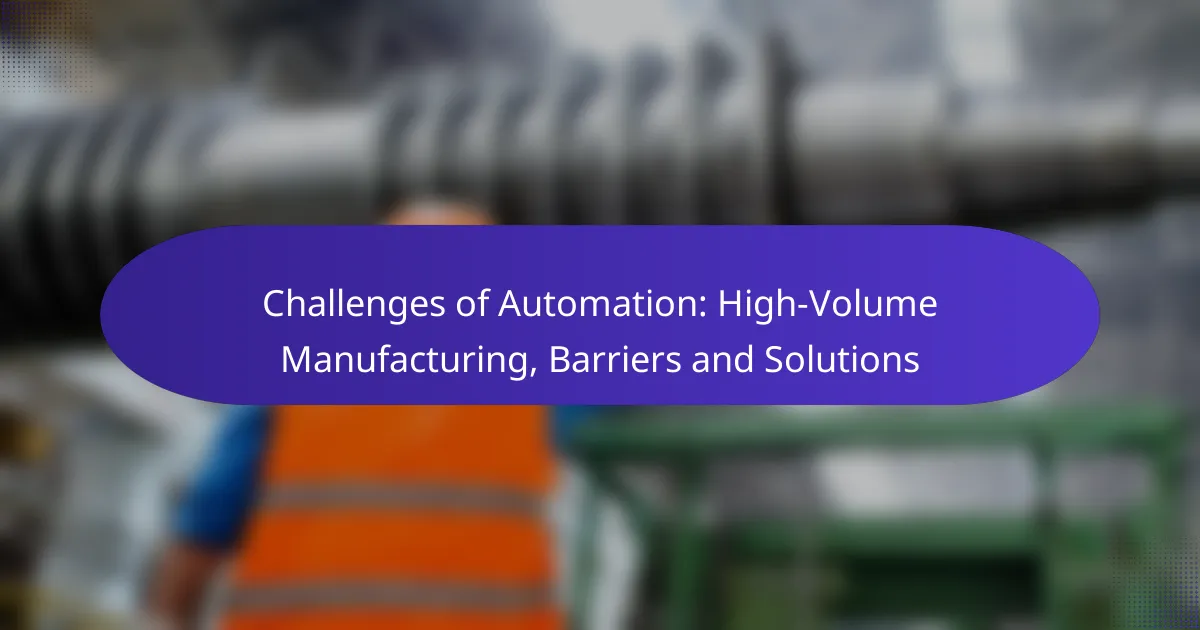Small manufacturers have the opportunity to transform their operations by adopting automation solutions that enhance efficiency and drive cost savings. By integrating advanced technologies into their workflows, these businesses can reduce labor costs, minimize errors, and ultimately improve their competitiveness in the market. Embracing automation not only streamlines processes but also positions small manufacturers for greater profitability and success.

How can small manufacturers benefit from automation solutions?
Small manufacturers can significantly enhance their operations through automation solutions, which streamline processes, reduce costs, and improve overall productivity. By integrating technology into their workflows, these businesses can achieve greater efficiency and competitiveness in the market.
Increased production efficiency
Automation solutions enable small manufacturers to optimize their production processes, leading to faster turnaround times and reduced waste. For example, automated machinery can operate continuously, increasing output while minimizing human error.
Implementing automation can lead to production efficiency gains of 20-30%, depending on the specific processes being automated. This allows manufacturers to meet demand more effectively and respond to market changes swiftly.
Reduced labor costs
By automating repetitive tasks, small manufacturers can lower their labor costs significantly. Automation reduces the need for manual labor in areas such as assembly, packaging, and quality control, allowing businesses to allocate resources more strategically.
In many cases, companies can achieve labor cost savings of 15-25% by adopting automation technologies. This shift not only cuts expenses but also allows employees to focus on higher-value tasks that require human oversight and creativity.
Improved product quality
Automation enhances product quality by standardizing processes and minimizing variability. Automated systems can consistently perform tasks with precision, leading to fewer defects and higher overall quality in manufactured goods.
For instance, automated quality control systems can detect defects in real-time, ensuring that only products meeting quality standards reach customers. This can lead to a reduction in returns and increased customer satisfaction.
Enhanced scalability
Automation solutions provide small manufacturers with the flexibility to scale operations quickly in response to market demands. As production needs increase, automated systems can be adjusted or expanded without significant downtime or retraining of staff.
This scalability is crucial for small manufacturers looking to grow, as it allows them to increase production capacity efficiently. Investing in modular automation systems can facilitate this growth, enabling businesses to adapt to changing market conditions seamlessly.

What are the cost savings associated with automation in small manufacturing?
Cost savings from automation in small manufacturing can be significant, primarily through reduced labor costs and improved efficiency. By implementing automation solutions, small manufacturers can streamline operations, minimize errors, and ultimately enhance profitability.
Lower operational expenses
Automation can lead to lower operational expenses by reducing the need for manual labor and minimizing human error. For instance, automated machinery can operate continuously, leading to higher output without the associated labor costs of overtime or additional staffing.
Small manufacturers should consider the initial investment in automation against the long-term savings. While upfront costs can be substantial, the reduction in labor costs and increased production efficiency often results in a favorable payback period, typically within a few years.
Decreased waste and rework
Implementing automation helps decrease waste and rework by ensuring precision in manufacturing processes. Automated systems can consistently produce high-quality products with fewer defects, which reduces the costs associated with scrap materials and reprocessing.
For example, a small manufacturer using automated quality control systems can quickly identify defects during production, allowing for immediate corrections. This proactive approach not only saves money but also enhances customer satisfaction by delivering reliable products.
Long-term ROI on equipment
The long-term return on investment (ROI) for automated equipment can be substantial, as these systems often have a lifespan that extends beyond traditional machinery. Investing in automation can lead to lower maintenance costs and improved reliability over time.
Small manufacturers should evaluate the total cost of ownership, including maintenance and energy consumption, when considering automation. Many automated solutions are designed to be energy-efficient, which can further enhance savings and contribute to a quicker ROI.

Which automation solutions are most effective for small manufacturers?
Small manufacturers can benefit significantly from automation solutions that enhance productivity and reduce costs. The most effective options include robotic process automation, machine learning applications, and industrial IoT implementations, each offering unique advantages tailored to specific operational needs.
Robotic process automation
Robotic process automation (RPA) streamlines repetitive tasks by using software robots to handle data entry, invoicing, and order processing. This technology can reduce human error and free up staff for more complex activities, leading to improved efficiency.
Small manufacturers should consider RPA for tasks that are rule-based and high-volume. Implementing RPA can lead to cost savings of around 20-30% in operational expenses, depending on the processes automated.
Machine learning applications
Machine learning applications enable small manufacturers to analyze large datasets and improve decision-making. These systems can predict equipment failures, optimize supply chains, and enhance product quality by identifying patterns and anomalies.
To effectively utilize machine learning, manufacturers should start with clear objectives, such as reducing downtime or improving inventory management. Investing in machine learning can result in efficiency gains of 10-20%, making it a worthwhile consideration for growth.
Industrial IoT implementations
Industrial IoT (IIoT) connects machinery and devices to the internet, allowing for real-time monitoring and data collection. This connectivity helps small manufacturers track performance metrics, manage maintenance schedules, and improve overall operational efficiency.
Implementing IIoT can require an initial investment, but the long-term benefits often outweigh the costs. Small manufacturers can expect to see a reduction in operational costs by 15-25% through better resource management and predictive maintenance strategies.

What factors should small manufacturers consider when choosing automation solutions?
Small manufacturers should evaluate several key factors when selecting automation solutions, including budget constraints, integration capabilities, and vendor support. Each of these elements plays a critical role in ensuring that the chosen solution meets operational needs while delivering cost savings and efficiency gains.
Budget constraints
Budget constraints are often the most significant factor for small manufacturers when choosing automation solutions. It’s essential to establish a clear budget that includes not only the initial purchase cost but also ongoing maintenance, training, and potential upgrades.
Consider solutions that offer a good balance between upfront costs and long-term savings. For example, investing in a more expensive system that provides substantial efficiency gains may yield better returns than opting for the cheapest option available.
Integration with existing systems
Integration with existing systems is crucial for the seamless operation of automation solutions. Small manufacturers should assess how well a new automation system will work with their current equipment and software to avoid disruptions.
Look for solutions that offer compatibility with existing technologies or provide APIs for easy integration. This can minimize downtime and reduce the need for extensive retraining of staff, which can be costly and time-consuming.
Vendor support and training
Vendor support and training are vital components of a successful automation implementation. Small manufacturers should prioritize vendors that offer comprehensive support services, including installation assistance, troubleshooting, and ongoing maintenance.
Additionally, consider the training options available for staff. Effective training can significantly enhance the adoption of new systems and ensure that employees are confident in using the technology, ultimately leading to better operational efficiency.

How do automation solutions impact workforce dynamics in small manufacturing?
Automation solutions significantly alter workforce dynamics in small manufacturing by reshaping job responsibilities and skill requirements. These technologies can enhance productivity and efficiency, but they also necessitate a reevaluation of employee roles and training needs.
Shift in job roles
The introduction of automation often leads to a shift in job roles within small manufacturing firms. Employees may transition from manual tasks to more supervisory or technical positions, focusing on overseeing automated systems rather than performing repetitive tasks. For example, a worker who once operated machinery may now be responsible for monitoring automated processes and ensuring quality control.
This shift can lead to more engaging work, as employees take on roles that require problem-solving and critical thinking skills. However, it also demands a clear understanding of how automation integrates into existing workflows.
Need for upskilling
As automation technologies evolve, there is a growing need for upskilling the workforce. Employees must acquire new competencies to effectively manage and maintain automated systems. Training programs should focus on technical skills, data analysis, and system troubleshooting to prepare workers for their new roles.
Small manufacturers can consider partnerships with local vocational schools or online training platforms to facilitate this upskilling. Investing in employee development not only enhances productivity but also boosts morale and retention rates.
Potential job displacement
While automation can improve efficiency, it may also lead to potential job displacement in small manufacturing. Some positions may become redundant as machines take over tasks previously performed by humans. This can create uncertainty among employees regarding job security.
To mitigate the impact of displacement, manufacturers should proactively communicate with their workforce about the changes and provide support through retraining initiatives. Offering pathways to new roles within the company can help retain talent and maintain a motivated workforce.

What are the common challenges faced by small manufacturers in implementing automation?
Small manufacturers often encounter several challenges when implementing automation, including high initial investments and resistance to change. These obstacles can hinder the adoption of automation technologies that could significantly enhance efficiency and cost savings.
High initial investment
The high initial investment required for automation can be a significant barrier for small manufacturers. Costs may include purchasing equipment, software, and the necessary infrastructure upgrades. Depending on the complexity of the automation system, these expenses can range from thousands to hundreds of thousands of dollars.
To mitigate these costs, small manufacturers can consider phased implementation, starting with simpler automation solutions that require lower upfront investments. Additionally, exploring financing options or government grants specifically aimed at supporting small businesses in adopting technology can help ease the financial burden.
Resistance to change
Resistance to change is a common challenge that small manufacturers face when implementing automation. Employees may fear job loss or feel overwhelmed by new technologies, leading to reluctance in adopting automated processes. This cultural barrier can slow down the transition to more efficient operations.
To address this resistance, manufacturers should prioritize employee training and involve staff in the automation planning process. Clear communication about the benefits of automation, such as reduced workload and improved job satisfaction, can also help alleviate fears and foster a more positive attitude toward change.



